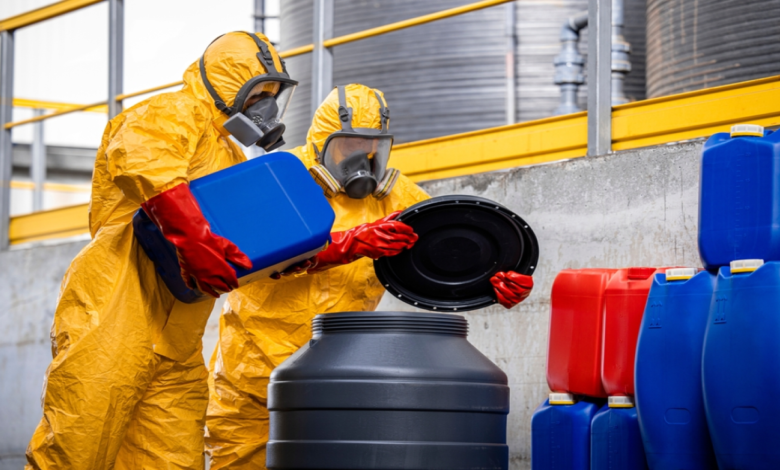Safeguarding Health Against Hazardous Chemicals in the Workplace

Hazardous chemicals are present in almost every workplace, from manufacturing plants to office spaces.
This blog explores common workplace hazardous chemicals and associated safety measures. We’ll also discuss regulations for hazardous chemicals in the UK and how training helps compliance and safeguards workers’ health.
Definition of Hazardous Chemicals
Hazardous chemicals refer to substances that can cause harm to health, property or the environment. These chemicals may exhibit properties such as toxicity, flammability, reactivity or corrosiveness.
Common Hazardous Chemicals at Workplaces
Here are some of the common hazardous chemicals found in workplaces:
- Cleaning Agents: While essential for maintaining hygiene, cleaning agents often contain harsh chemicals that can irritate the skin and respiratory system.
- Hydrochloric Acid: Widely used for metal cleaning and food processing, hydrochloric acid must be handled cautiously. Inhalation can cause respiratory irritation, while skin contact may result in burns.
- Benzene: Benzene is widely used for plastic and synthetic fibre production. Prolonged exposure can affect blood cell production and cause cancer.
- Solvents and Thinners: Commonly used in manufacturing and industrial processes, solvents and thinners emit fumes that may lead to respiratory issues when inhaled.
- Heavy Metals: Certain industries use lead, mercury, cadmium and other heavy metals. Prolonged exposure can lead to serious health complications such as neurological issues, kidney damage and reproductive concerns.
Safety Measures to Prevent Hazardous Chemical Exposure
Effective safety measures must be implemented to protect employees working with hazardous chemicals, including:
- Risk Assessment: A legal requirement. Employers must conduct thorough risk assessments to identify potential hazards and establish preventive measures.
- Personal Protective Equipment (PPE): Employers must also provide appropriate PPE such as gloves, goggles, respirators, and protective clothing to minimise direct contact with hazardous substances. The level and type of PPE required is determined by the risk assessment.
- Ventilation Systems: It may be necessary to install ventilation systems to control and reduce the concentration of airborne chemicals depending on the risk assessment.
- Training and Education: Employees must be educated on the risks associated with hazardous chemicals as well as proper handling and emergency response procedures.
- Emergency Response Plans: Developing and regularly rehearsing emergency response plans is crucial. Safety drills help employees promptly address chemical spills, leaks, or accidents.
Health and Safety Regulation for Hazardous Chemicals
1. Control of Substances Hazardous to Health Regulations 2002 (COSHH):
COSHH is a comprehensive set of UK regulations requiring employers to assess and control the risks posed by hazardous substances. It encompasses identification, assessment, control measures, monitoring and training to ensure a systematic approach to managing chemical risks in the workplace.
2. Chemicals (Hazard Information and Packaging for Supply) Regulations 2009 (CHIP):
CHIP regulates the classification, packaging, and labelling of chemical substances to ensure clear communication of hazards. It aligns with the Globally Harmonized System (GHS), enhancing the consistency and effectiveness of hazard communication globally.
3. The Dangerous Substances and Explosive Atmospheres Regulations 2002 (DSEAR):
DSEAR focuses on protecting workers from the risks of fire, explosion and substances that can create explosive atmospheres. It requires employers to assess and mitigate these risks, emphasising the importance of proper control measures and safety precautions in workplaces handling dangerous substances.
4. The Carriage of Dangerous Goods and Use of Transportable Pressure Equipment Regulations 2009 (CDG 2009):
CDG 2009 regulates the transportation of dangerous goods, including hazardous chemicals. It sets standards for packaging, labelling and transporting such goods safely. The regulations apply to various modes of transport, ensuring consistency and safety when handling and transporting hazardous materials.
Importance of COSHH Training
COSHH training is pivotal in maintaining a secure and compliant workplace. This specialised training equips workers with essential hazardous substance knowledge, promoting proper handling techniques and regulatory compliance. It also develops emergency preparedness, enabling swift and effective responses during chemical incidents.
Conclusion
Safeguarding health in the workplace against hazardous chemicals requires a multi-faceted approach. Employers can create a secure working environment where hazardous chemical risks are successfully controlled through diligent risk assessment, implementation of safety measures and continuous training.
You May Also Read: The Ripple Effect of Rest: How Sleep Powder Transforms Health and Lifestyle




